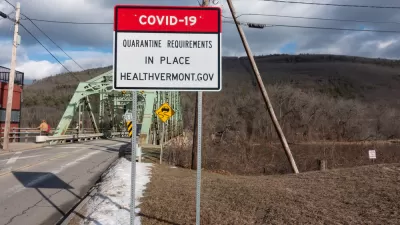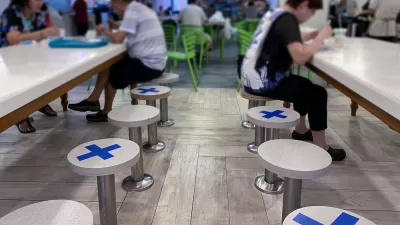Vision Zero: a strategy to eliminate road crashes, particularly those with fatal outcomes. COVID Zero: a strategy to end coronavirus transmission. Only one has worked—but at a steep price.

On Monday, 13 million Chinese residents in Xi'an were released from a 32-day lockdown that Chinese authorities had initiated after "more than 140 domestically transmitted infections with confirmed symptoms since Dec. 12 in its latest cluster caused by the Delta variant of the coronavirus," as Reuters reported on December 22, 2021.
'Lockdown' is a loaded word and should be used sparingly, as the extreme public health and safety measure goes far beyond any coronavirus business or gathering restrictions experienced in the U.S., as the Reuters report illustrated.
Starting Thursday [Dec. 23], only one person in each Xian household can go out for necessary shopping every two days, while other family members must stay home unless they have essential jobs, Xian government official Zhang Fenghu told a news briefing.
"The harsh lockdown in Xi’an became a symbol of the extreme measures that China’s government has taken to control Covid after testimonies emerged on Chinese social media of problems including people struggling to get enough food," report John Liu and Paul Mozur for The New York Times on January 24.
In other cases, those in need of medical care were denied entry to hospitals because of stringent epidemic prevention measures. In one case, a pregnant woman was refused treatment because of an expired coronavirus test. She later lost her child.
COVID Metrics
While extreme, the Chinese government credits their Zero Covid strategy for containing the coronavirus and achieving the "path to near-zero case incidence," as Harvard scholar Danielle Allen described in an early pandemic post.
On the day the lockdown was lifted, China averaged 87 infections, or less than 1 per 100,000 people, according to The New York Times global coronavirus tracker. Daily average deaths were zero. The World Health Organization's COVID tracker for China shows the last two COVID deaths were recorded on Jan. 10 and on Dec. 20.
By contrast, the U.S. approach to the pandemic has resulted in over 2,000 people dying daily since Jan. 20 from "a preventable and treatable disease," in the words of the director-general of the World Health Organization, Tedros Adhanom Ghebreyesus.
On Jan. 24, the U.S. averaged over 738,000 cases, according to the Times, a daily case incidence of 223 per 100,000 people. Daily average deaths exceeded 2,360, a rate of 0.71 deaths per 100,000 people. Russia had the second-highest average daily deaths, nearly 670, a rate of 0.46 per 100,000 people.
Sustainable?
"But many cases have involved the highly transmissible Omicron variant, and with each passing day, the government’s dogged pursuit of “zero Covid” is looking harder to achieve," wrote New York Times correspondents Amy Qin and Amy Chang Chien on Jan. 21. "Many wonder how long it can be maintained without causing widespread, lasting disruptions to China’s economy and society."
Related in Planetizen:
- Living (and Dying) with COVID: How Many Deaths are Acceptable? July 28, 2021
- Do You Know Your COVID-19 Colors? July 29, 2020
- Suppression or Mitigation? The Language of Coronavirus Containment, March 31, 2020
FULL STORY: China lifts a monthlong lockdown on the 13 million residents of the city of Xi’an.

Study: Maui’s Plan to Convert Vacation Rentals to Long-Term Housing Could Cause Nearly $1 Billion Economic Loss
The plan would reduce visitor accommodation by 25,% resulting in 1,900 jobs lost.

North Texas Transit Leaders Tout Benefits of TOD for Growing Region
At a summit focused on transit-oriented development, policymakers discussed how North Texas’ expanded light rail system can serve as a tool for economic growth.

Why Should We Subsidize Public Transportation?
Many public transit agencies face financial stress due to rising costs, declining fare revenue, and declining subsidies. Transit advocates must provide a strong business case for increasing public transit funding.

How to Make US Trains Faster
Changes to boarding platforms and a switch to electric trains could improve U.S. passenger rail service without the added cost of high-speed rail.

Columbia’s Revitalized ‘Loop’ Is a Hub for Local Entrepreneurs
A focus on small businesses is helping a commercial corridor in Columbia, Missouri thrive.

Invasive Insect Threatens Minnesota’s Ash Forests
The Emerald Ash Borer is a rapidly spreading invasive pest threatening Minnesota’s ash trees, and homeowners are encouraged to plant diverse replacement species, avoid moving ash firewood, and monitor for signs of infestation.
Urban Design for Planners 1: Software Tools
This six-course series explores essential urban design concepts using open source software and equips planners with the tools they need to participate fully in the urban design process.
Planning for Universal Design
Learn the tools for implementing Universal Design in planning regulations.
City of Santa Clarita
Ascent Environmental
Institute for Housing and Urban Development Studies (IHS)
City of Grandview
Harvard GSD Executive Education
Toledo-Lucas County Plan Commissions
Salt Lake City
NYU Wagner Graduate School of Public Service





























